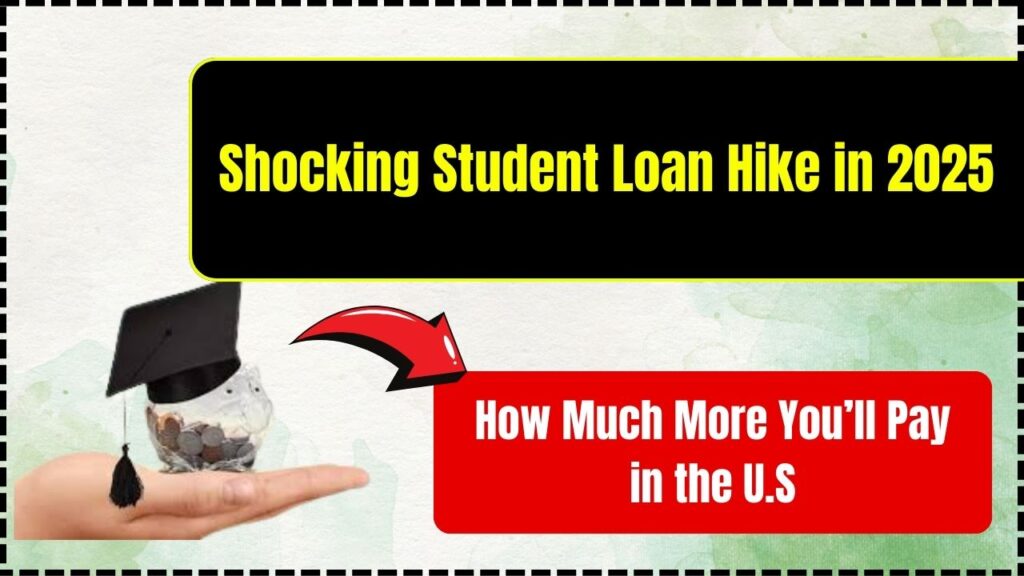Shocking Student Loan Hike in 2025: If you’re a student, parent, or professional in the United States, you’ve likely heard some disturbing news lately: student loans are getting more expensive in 2025. This isn’t just a minor uptick or a passing headline—we’re talking about the largest increase in federal student loan interest rates in more than a decade. Whether you’re preparing to borrow for the first time, currently enrolled in school, or already repaying existing loans, this new development could have a profound impact on your financial plans and long-term goals.

But don’t worry—you’re not alone. In this comprehensive guide, we’ll explore everything you need to know about these changes. We’ll walk you through why this is happening, what it means for your wallet, and how to best respond, whether you’re a high school senior, a graduate student, or a parent trying to support your child.
Shocking Student Loan Hike in 2025
| Topic | Details |
|---|---|
| New Interest Rates (2024-2025) | Undergraduate: 6.53%; Graduate: 8.08%; PLUS Loans: 9.08% (source) |
| Year-Over-Year Increase | Up 1.03% from last academic year |
| Estimated Added Cost | ~$465 more in interest for $7,500 over 10 years |
| Policy Change (May 2025) | Spousal income included in repayment calculations (source) |
| Proposed Legislation | Affordable Loans for Students Act: 2% interest cap (official site) |
The 2025 student loan hike is more than just an economic adjustment—it’s a critical moment in the story of higher education finance. With interest rates at multi-decade highs and sweeping policy shifts on the table, students and families must be more strategic than ever.
By understanding what’s changing, preparing proactively, and seeking out trustworthy information, you can navigate these challenges with clarity and confidence. Education is a powerful investment—and with the right knowledge, it doesn’t have to become an unmanageable burden.
Why Are Student Loans Getting More Expensive?
Student loans don’t exist in a vacuum. Their cost is directly tied to broader economic trends. The rising cost of federal student loans in 2025 stems from the increasing U.S. Treasury bond yields. These yields are heavily influenced by the Federal Reserve’s policy decisions, especially efforts to control inflation by raising interest rates across the board.
Here’s how it works:
- The federal government sets new student loan interest rates every July based on the yield of the 10-year Treasury note.
- When inflation rises, the Fed increases its base rates.
- This leads to a higher yield on Treasury bonds.
- In turn, federal student loan rates go up.
This means the class of 2025 is borrowing under conditions that are significantly more expensive than those just a few years ago. Students and families may end up paying thousands of dollars more over the life of a loan, depending on how much they borrow.
Breaking Down the Numbers
New Federal Student Loan Rates (2024-2025)
- Undergraduate Direct Subsidized and Unsubsidized Loans: 6.53% (was 5.50%)
- Graduate Direct Unsubsidized Loans: 8.08% (was 7.05%)
- Parent and Graduate PLUS Loans: 9.08% (was 8.05%)
These rates may not seem alarming at first glance, but the difference in long-term repayment is substantial.
Example: If you borrow $7,500 for an undergraduate degree at 6.53%, you’ll pay nearly $2,750 in interest over 10 years. That’s about $465 more than if you’d borrowed the same amount at 5.50%.
For graduate students, the stakes are even higher. A $20,000 loan at 8.08% instead of 7.05% translates into more than $1,200 in extra interest over a standard 10-year repayment period.
Families using Parent PLUS loans face even steeper increases. At 9.08%, PLUS loans are some of the most expensive federal loan options available.
These numbers underscore the importance of understanding how much you’re borrowing, what type of loan you’re using, and how those details will shape your financial life for years to come.
How Will Policy Changes Impact You?
Beyond rising interest rates, several key policy changes are set to take effect in 2025 that may drastically alter how much borrowers owe and how easily they can repay their loans.
Spousal Income Now Included in Repayment Calculations
Beginning in May 2025, married borrowers using income-driven repayment (IDR) plans will no longer be able to exclude their spouse’s income if they file taxes separately. This means your household income—not just your individual income—will be considered when calculating monthly payments.
This change could increase monthly payments for tens of thousands of borrowers, particularly those in dual-income households or where one spouse earns significantly more.
The Project 2025 Plan: What You Should Know
This controversial proposal could reshape federal student loan repayment for millions. Key changes include:
- Consolidation of IDR plans into a single, less flexible option
- Elimination of Public Service Loan Forgiveness (PSLF)
- Stricter income thresholds and eligibility rules
- Reduction in repayment options for low-income borrowers
According to the Center for American Progress, borrowers could see their annual payments rise by $2,700 to $4,300, depending on their educational background and career trajectory. This proposal has not been implemented yet, but it’s generating significant concern across the education and financial sectors.
What Can You Do About It?
Don’t panic—there are practical steps you can take right now to protect yourself and your finances.
1. Review Your Repayment Plan
Federal student loan borrowers can choose from a variety of repayment plans. If your financial situation is tight, look into Income-Driven Repayment (IDR) plans, which cap payments based on a percentage of your income. The Loan Simulator tool from Federal Student Aid can help you compare your options.
2. Consider Refinancing (But Carefully)
Private refinancing could lower your interest rate—but it’s not for everyone. Refinancing is generally best for those with strong credit, steady employment, and little need for federal protections like deferment, forbearance, or forgiveness. Be sure to compare offers from multiple lenders before making a decision.
3. Track Legislation and Advocacy Efforts
The proposed Affordable Loans for Students Act could dramatically reduce interest rates to 2% and apply this retroactively. It would also allow for automatic refinancing of current loans. You can follow updates on this legislation via the official congressional site.
$2,909 Social Security Payment for Married Couples – Who Qualifies This Week?
$5,108 a Month? Here Are 5 Smart Ways to Maximize Your Social Security
Over $5,000 Available for Pre-1997 Check Holders – What is the Eligibility and Applying process
4. Borrow Less When Possible
Reassess how much you need to borrow. Look into scholarships, grants, tuition waivers, and work-study programs. Every dollar you avoid borrowing today is a dollar you won’t have to repay (plus interest) later.
5. Stay Informed and Ask Questions
Your school’s financial aid office, your loan servicer, or a certified financial planner can help you make better borrowing and repayment choices. Don’t hesitate to reach out and get personalized advice.
FAQs On Shocking Student Loan Hike in 2025
Will student loan rates go up again next year?
Possibly. Rates depend on economic trends, especially the 10-year Treasury yield. If inflation stays high, expect further increases. Monitor financial news each spring before new rates are set in July.
Can I lock in a lower rate now?
Federal loans have fixed rates once disbursed, but you can’t lock in future lower rates early. Some private lenders may allow early application or fixed-rate options.
Is refinancing a good idea in 2025?
It could be. If you have strong financial standing, refinancing may reduce your rate. But remember, refinancing with a private lender means giving up federal protections. Weigh pros and cons carefully.
What if I can’t afford payments after the new policies take effect?
Don’t panic. Options like deferment, forbearance, and IDR plans may provide relief. Contact your loan servicer early to avoid missed payments or default.
Is there any chance student debt will be forgiven?
Forgiveness programs like PSLF still exist, though their future is uncertain under new policy proposals. Keep records, certify employment annually, and stay informed on changes.








